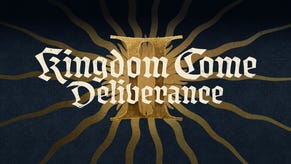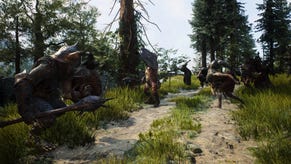Fenix nights: Gears of War 3 – four-player co-op hands-on
Ahead of its launch next month, we check out the opening chapter of Epic’s four-player co-op war against the Locust. Includes words from Rod Fergusson and new screens and video.
Gears of War 2’s narrative arc involving Dom’s search for his abducted wife Maria concluded with a sucker punch. A pay-off that artfully elevated the otherwise hackneyed search and rescue plot device to stand as more than the sum of its parts.
The ruinous state of Maria’s physical and mental being illustrated that, irrespective of the macho bravado and it’ll-be-alright-on-the-night Hollywood-flavoured storyline of war against the Locust, the more personal battles being fought along the way could still pack an emotional punch. It was a more affecting moment than the fall of an entire city and far less comically inevitable than the fate of a certain rookie soldier.
So, in ramping up the number of playable protagonists from the previous instalment, Epic is mindful that each player should feel involved in the story - to not be made to feel like a faceless gun for hire; to have their own moments of narrative significance.
“There were a bunch of challenges for designing levels for four players and not just two,” Gears’ executive producer Rod Fergusson tells me after a four-player co-op session of chapter one. “Initially it started with the narrative: we had to think about how we create narrative that has four players in every scene.
“We were determined to ensure that our four player co-op wasn’t in the mould of ‘one hero and four clones’; that we wouldn’t just pretend that the other three players didn’t really exist in the story or in cut scenes.”
This task was largely the domain of UK author and international bestseller, Karen Traviss, whose appointment as lead writer on Gears 3 was a boon, as Fergusson describes it.
“Part of what we’re trying to do with the story is ensure each character is involved in the narrative and make it that much more personal,” he explains. “So, we have Marcus and his Dad alongside these ‘can’t go home stories’ of Cole and of Hoffman going back to Anvil gate. All of this stuff is us trying to tap into Karen’s expertise in writing books and novels and having deeper stories that we apply to our characters.”
Four play
With the narrative placed firmly in safe hands, Epic has focused on how best to make the busy business of running and gunning work for four players. Fergusson has previously spoken about the requirement to provide cover positions and flanking opportunities for four players and how, to facilitate this, Epic has gone back to the “combat bowls” of the first game – large, sealed off, arena-type areas in which battles can be pitched and players can work cooperatively without getting in each other’s way.
Our play-through of chapter one presents a number of these areas: from the large floating fortress the Gears now call home to town squares, sprawling warehouses and even a football stadium, each with sufficient space to accommodate the multiple burly forms rendered by the Unreal Engine.
The concerted effort of our four human-players against hardcore-level opposition reveals that the game is no pushover, although Fergusson later explains that casual mode has been made easier to eliminate the barrier of entry for new players.
We lack headsets, so are unable to effectively communicate above the general hubbub of the dozen or so demo pods present, but despite this being chapter one and us being four players with varying levels of Gears experience, we see the game over screen more times than one might expect as one, some or all of us bleed-out at various times.
This is due, in no small part, to the Lambent: mutated Locust foes, misshapen and twisted by the effects of the Imulsion that has infected them. The Lambent are Epic’s specific and focused response to the threat of having four humans able to coordinate their efforts and they offer far tougher resistance than their less deformed Locust brethren.
“We looked very carefully at the difficulty issue, knowing that four human players would be much more effective than one player with AI bots,” Fergusson confirms. “We were aware that if all four players were to concentrate their fire on one enemy then they’re going to just mow them down, so that’s where the idea for the Lambent design came in.
“Now, we have enemies that are strong enough to counter that threat, that have the ability to mutate and shoot at multiple people at a time or to shoot over cover to drive players out into the open. They may also explode if players get in too close and just generally harder to kill. All of this is to deal with the difficulty level issues and to avoid players just tearing through the game.”
You’ll never walk alone
So, the boxes marked inclusive narrative and balanced combat have been checked as far as four-player co-op is concerned. Elsewhere, the feel, tone and palette of the game are much as they’ve ever been. Perhaps understandably, Epic is choosing to refine the concepts that have defined its flagship franchise, rather than bringing eleventh hour overhauls to its tried, tested and hugely popular formula. Stepping away from the campaign mode, these refinements can be further seen in the more familiar multiplayer arena of Horde and its monster-mash equivalent, Beast.
Horde has gained a pseudo-strategic undercurrent in the form of fortifications that can be used against the ceaseless waves of Locust, Lambent and the bosses that appear every tenth wave. In a move that is further intended to remove barriers of entry to new players but that may also limit the capacity for strategists to create artificial choke-points, each of the five types of fortifications – barriers, decoys, sentries, turrets and the mech-suit Silver Backs – can only be deployed at predefined locations around command posts.
The result, Fergusson hopes, is a mode that now services players’ desires to do more than just shoot things in the face but that remains accessible to those who may be coming to Gears’ multiplayer for the first time.
“Horde is a mode that players that are a little intimidated by standard multiplayer or those that want to have a more co-operative multiplayer experience can enjoy,” he explains. So, we didn’t want to overcomplicate the core mode, which is why we have the idea of these predefined fortifications: we’re looking for that happy medium of providing interest with skill progression and variety but at the same time not making it really difficult.”
Fortifications will not feature in campaign mode in any form, with Fergusson telling us that “it wasn’t something that we wanted to go back and add in”, but Beast mode – in which you play as Locust taking down AI-only controlled humans – will feature it, albeit in modified form as you attempt to storm the trenches of the heroes and must “overcome the fortifications and deal with laser fences and whatnot.”
Alongside the lowered barrier for entry and multiple options for co-op is the addition of a graduated versus multiplayer. This latter feature is intended to ensure those big fish that have extensive experience of previous Gears games or the Gears 3 beta are kept out of the relatively small pond of casual multiplayer.
In Gears 3, Epic seems intent on providing the definitive Gears experience for new players and old hands alike. We must wait to see if that experience can sustain engaging four-player combat without feeling contrived, whilst simultaneously delivering a narrative with the potential to punch you in the heart.
Gears of War 3 launches for Xbox 360 on Tuesday September 20 in the US and PAL territories.




















